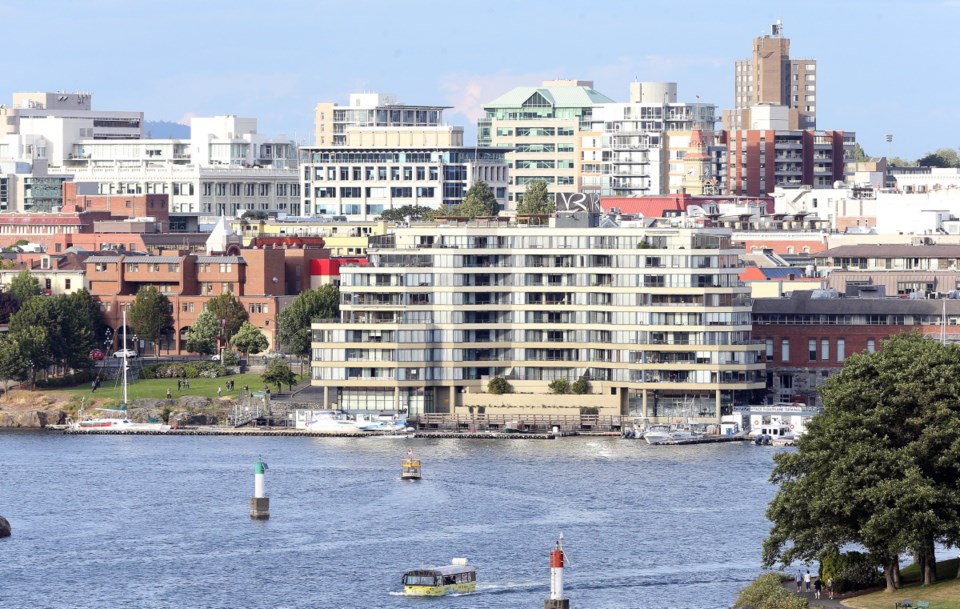Statistics Canada reported in March that Victoria is Canada’s seventh most densely populated city. However, at 85,792 residents, it is small compared to its metropolitan region (367,770 residents). Greater Victoria saw the highest population-growth rate (6.7 per cent) of all B.C. metropolitan areas during the past five years.
These numbers suggest that, while many people are moving into Victoria’s new highrises, more prefer the outlying municipalities, where single-family dwellings are increasing in number. According to patterns identified a few years back by urban physical scientists, the combination means more driving, increased energy use and greater need for far-flung regional services such as sewer, water and garbage collection in the region’s future.
If the Greater Victoria region were an animal, it would be small but flabby, and likely unable to climb a flight of stairs without stopping to groom itself and breathe — perhaps like one of those overfed house cats lolling about the Internet.
Cities are often compared to animals. They have pulses. Their energy consumption is like metabolism. Grocery stores serve as their stomachs. Freeways and major thoroughfares are the arteries along which goods are moved. Smaller, capillary-like streets lead into neighbourhoods.
Urban physicists have moved beyond the metaphors and started applying biological-like math to cities. They gathered data on everything from gas stations, income, illness, murders, coffee shops and pedestrians’ walking speeds. They analyzed the chaos and complexity, then reduced everything to simple mathematical equations that describe cities’ underlying, universal, interrelated patterns.
For example, if we measured the average walking speed of pedestrians in downtown Victoria, the equations would allow us to roughly determine how many people live in Victoria, the average income here, and the number of corporate headquarters, museums, art galleries and high-end restaurants in the city.
The math doesn’t capture everything, and it might produce wonky results when applied to atypical variables — for example, the maddeningly slow ambling of summer tourists along Government Street. However, the equations usually produce estimates with about 85 per cent accuracy.
It’s hard to believe a city’s messiness can be reduced to equations. Yet math has clarified fundamental patterns within another diverse and complex system.
About 70 related mathematical laws describe how animals work. The equations capture underlying biological patterns seen in all species and define relationships between variables such as heart rate, size and food intake. No matter what an animal looks like or where it lives, the math usually works.
For example, it describes how an animal’s energy needs relate to its mass. An adult elephant clocks in at 5,440 kilograms and eats up to 270 kilograms of food a day — five per cent of its body weight. A hummingbird weighs 2.5 to 4.5 grams and burns food so fast, it must eat 1.5 to three times its body weight in food each day.
(If elephants had hummingbird metabolisms, the Serengeti would likely have turned to desert long ago.)
Math also predicts how, as an animal grows, its volume grows faster than its surface area, with implications for animals, city planners and engineers. Large animals have a harder time cooling themselves than small animals, and small animals have greater difficulty retaining heat in cold weather. This is why small children must bundle up in cool weather while their mommies go about in yoga gear.
Applying these and similar laws to cities, urban physicists calculated that, as a city grows and its population density increases, the city consumes less energy overall and more efficiently. People in big, dense urban centres drive less, walk more and walk to work more often — and, therefore, tend to walk faster.
Food and other goods require less extensive transportation within these cities, leading to more efficient distribution. As well, bigger buildings and cities retain heat, with less energy used in winter (but more energy used for air conditioning in hot, muggy seasons).
However, these conclusions apply only if a city has few suburbs. Research has found that suburbs negate large city centres’ energy savings. As in the story of the three bears, mid-sized cities, without suburbs, are just right.
And Greater Victoria, roly-poly spreading out on its soft South Island sofa, is too small and sparsely populated overall to see those efficiencies.



